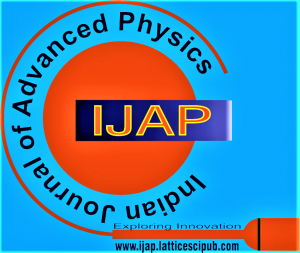![]()
Relative Nature of Electric Permittivity and Magnetic Permeability of Electromagnetic Wave
Chandra Bahadur Khadka
Chandra Bahadur Khadka, Student of Trichandra Multiple Campus, Tribhuvan University, Kathmandu, Nepal.
Manuscript received on 27 March 2022 | Revised Manuscript received on 07 April 2022 | Manuscript Accepted on 15 April 2022 | Manuscript published on 30 April 2022 | PP: 17-25 | Volume-2 Issue-1, April 2022 | Retrieval Number: 100.1/ijap.C1021041322 | DOI: 10.54105/ijap.C1021.041322
Open Access | Ethics and Policies | Cite | Mendeley | Indexing and Abstracting
© The Authors. Published by Lattice Science Publication (LSP). This is an open-access article under the CC-BY-NC-ND license (http://creativecommons.org/licenses/by-nc-nd/4.0/)
Abstract: This research is about the special theory of relativity on electric permittivity and magnetic permeability of electromagnetic wave. For this, Four Maxwell’s electromagnetic equations play an important role. James Clerk Maxwell suggested that the light travel as electromagnetic wave which require no material medium for propagation. The speed of light (C) in free space is always constant and is independent of the speed of source or observer or the relative motion of the inertial system and has velocity ‘C’ given by![]() . So velocity of electromagnetic waves depend on obsolute magnetic permeability (μ0) and obsolute electric permittivity (ε0) of free space. These two physical quantities rely on relative motion of inertial system. So μ0 and ε0 are not obsolute quantity but are dependent upon the relative motion between the observer and the phenomenon observed. Electric and magnetic field of a charge rely upon the value of obsolute electric permittivity of medium. Concisely, μ0 and ε0 are variant quantity. Consequently electric and magnetic field get relative for electromagnetic wave. That is electric and magnetic field depend on relative motion of inertial system for electromagnetic waves.
. So velocity of electromagnetic waves depend on obsolute magnetic permeability (μ0) and obsolute electric permittivity (ε0) of free space. These two physical quantities rely on relative motion of inertial system. So μ0 and ε0 are not obsolute quantity but are dependent upon the relative motion between the observer and the phenomenon observed. Electric and magnetic field of a charge rely upon the value of obsolute electric permittivity of medium. Concisely, μ0 and ε0 are variant quantity. Consequently electric and magnetic field get relative for electromagnetic wave. That is electric and magnetic field depend on relative motion of inertial system for electromagnetic waves.
Keywords: Electric Permittivity, Electromagnetic Waves, Magnetic Permeability, Relativity
Scope of the Article: Electromagnetism and Optics
